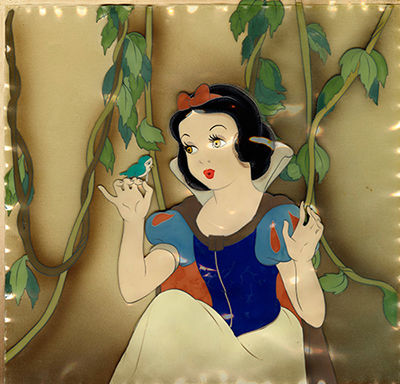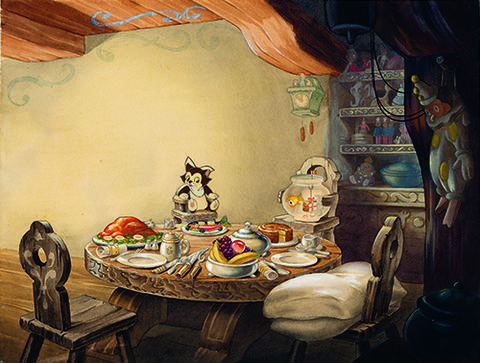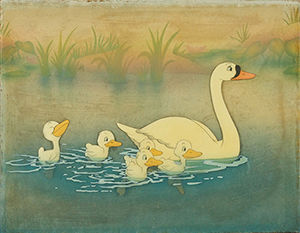
In the late 1930s, The Walt Disney Studios was riding on a tidal wave of success. With the profitable release of Snow White and the Seven Dwarfs in late 1937, along with the success of Mickey Mouse and the Silly Symphonies, The Walt Disney Studios was widely considered to be the pinnacle of quality animation. Walt and his team (which had grown to around a thousand employees) were no longer considered simply cartoonists, but were coming to be known as respected artists in both the film and art world. Guthrie Courvoisier, President of the highly esteemed Courvoisier Galleries in San Francisco, was aware of Disney’s escalating reputation, and saw vast opportunity in it. Guthrie believed that the Disney paintings on celluloid that were used to create Snow White could be sold as valuable art pieces to the public through art galleries and museums all over the world. And he was right.
Before taking steps to consult with Walt and his brother Roy, Guthrie approached The Walt Disney Studios’ successful merchandiser, Kay Kamen. Kamen was immediately on board with Guthrie’s plan, and took it a step further by licensing not only Courvoisier, but other companies, to sell Disney original cels. He convinced a St. Louis department store to do a trial run of the cels as a test to see how they would sell. Guthrie knew that department stores were not the correct avenue for esteemed fine art like the Disney cels, and wrote a polite letter to Kamen, Walt, and Roy asking them to reconsider. He penned: “Through my own business I have come to know many museum directors, most of the important art dealers of America and a great host of collectors and people interested in art. They have not only been amused by the Walt Disney animated cartoons, but have often expressed a great respect for Mr. Disney as an artist of profound ability in the same sense as a great painter or composer… They are after all not ordinary prints but original paintings from the hands of the Disney artists themselves, and as such open up a whole new field for their sale.” Guthrie believed that selling the cels through avenues such as department stores would cheapen the work, but that selling exclusively through a respected art gallery would entice high-end collectors and museums, and would cement Disney’s reputation as a respected figure in the art community. Walt and Roy agreed with Guthrie, and asked Kamen to halt sales in the department stores. On July 19th, 1938, they signed a contract exclusively with Courvoisier Galleries, making Guthrie the sole representative for marketing Disney original art.
Guthrie immediately began selling the Disney cels, banking on the world-wide popularity of Snow White. He began experimenting with pricing among collectors, reporting sales between $5 and $35 dollars, and one particularly popular Snow White piece for $50. He also released news of his contract with Disney to the media, which resulted in quite the buzz in newspapers all across the country. Exclusive galleries and museums all around the U.S. began exhibiting Disney cels in late summer of 1938 to resounding success. By the end of the year, Disney cels were being shown and sold in major cities all over the world. The following review in the Philadelphia Record from October of 1938 details the unprecedented success of the Courvoisier cels: “Down came the Rembrandts, the Dürers and the works of other old masters. And up went the picture of Grumpy being doused in the watering trough, a scene showing Sneezy and Dopey dancing with Snow White, the turtle’s rolling down the steps and other now famous scenes from Walt Disney’s ‘Snow White and the Seven Dwarfs.’” Gallery owners reported the best sales they had seen in years, and collectors flocked to get their hands on Walt Disney originals.

After the success of the Snow White cels, it was decided in 1939 that other types of Disney art should also be made available to the public in addition to the cels. This included original background paintings, story sketches, and animation drawings. It also expanded the market to include other Disney work, such as Silly Symphony shorts like Ferdinand the Bulland The Ugly Duckling. Gallery owners eagerly anticipated the coming releases of Pinocchio and Bambi, for which many had already placed advanced orders. Several of these Pinocchio cel set ups can be seen in our special exhibition Wish Upon a Star: The Art of Pinocchio, including a beautiful multi-layered cel of Monstro the whale, a gorgeously detailed layout featuring Figaro the cat waiting impatiently for his feast, and many more!
During this time, The Walt Disney Studios was responsible for preparing all the art pieces for sale as stated in the original contract. A crew of twenty artists at Disney’s was tasked with preparing the cels, and they could hardly keep up with the demand. Helen Nerbovig was the director of this team, and she stated that “Walt wanted every piece to be reminiscent of the film. I would look at the film and decide how each set-up was to be made, and I’d make the first one. Then everyone would follow my pattern.” There were many more character cels than there were backgrounds, so the Studios’ staff had to come up with creative ways to make new backgrounds. They used stencils, air brush, and wood veneers for backgrounds, but the costs of arranging the art were almost half of the income received for selling them. In addition, when Roy Disney priced out the cost of paying the artists and the supplies needed to prepare the art, he realized that this method was not particularly cost effective. Roy decided that after the release of Pinocchio in early 1940, he would ask Courvoisier to take over the task of preparing the artwork for sale. This Guthrie did willingly, and hired art students in San Francisco to help them with the task. Still, the demand was more than Courvoisier could reasonably handle. Guthrie had the idea to merchandise prints of the original art through department stores as a way to mediate the demand. The plan was not successful, however, as the prints did not achieve the popularity that the originals had, and the print business quickly folded. Guthrie was undaunted however, and continued selling originals to prestigious museums to great success.

With the start of World War II, business became difficult not only for The Walt Disney Studios’ films, but also for its fine art sales. Guthrie closed his gallery in 1942 in order to manufacture parts for military aircraft, but he continued to market the Disney originals through 1946. With the hardships of the war, interest in the original Disney art had tapered off significantly, and both Walt and Roy and Guthrie agreed that it would be best for Disney to market their own fine art henceforth. The Studios only released original art periodically from then on, until the opening of Disneyland in 1955 when the Tomorrowland Art Corner shop began selling original Disney art. Originals were sold at the Art Corner through the early 1970s. For a chance to see an original Courvoisier cel, stop by Gallery 3 the next time you visit our museum and look for The Ugly Duckling; you won’t be disappointed!

Tracie Timmer
Education Coordinator at The Walt Disney Family Museum
